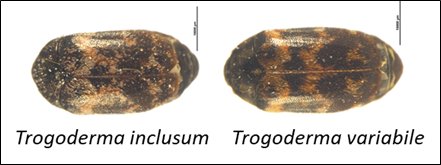About the Gerken Lab
What happens once crops leave the field? After a crop is harvested, there is usually some sort of storage that occurs before it is processed and sold to the consumer. Throughout the post-harvest supply chain, insect pests can inflict significant damage, sometimes rendering the commodity unusable and costing people even more money and time than already invested. The main goal of our lab is to develop solutions for managing insect pests in post-harvest commodities using ecological principles for overall integrated pest management. These ecological principles can include laboratory-based assays, field collections of insects, or computer modeling of spatial and environmental components that drive insect population growth.
If you’re interested in working in the Gerken lab, please contact Dr. Alison Gerken by sending an email with your research interests and a current CV or resume to alison.gerken@usda.gov.
If you’re interested in collaborating or would like more information on stored product insect pests, please contact Dr. Alison Gerken at the above email address as well.

Caption: Gerken Lab Circa June2024
Lab Members
Dr. Alison Gerken (Lead Scientist)
Ken Friesen (Technician)
Sonika Khosla (Biological Science Aid)
Anastasia Meyer (Biological Science Aid)
Rose Scott (Biological Science Aid)
Dawson Christensen (M.S. Student, co-advised by Yoonseong Park and Erin Scully)
Rachel R. Harman (ORISE SCINet Postdoctoral Fellow, co-advised by Rob Morrison)
Matthew Hetherington (Postdoctoral Fellow, co-advised by Rob Morrison)
Ronnie Serfa Juan (ORISE SCINet Postdoctoral Fellow, co-advised by Lester Pordesimo)
Ongoing Research Projects
Below is a brief overview of projects in the Gerken lab.

Jars of a variety of flours, prepared for use in experimental assays. (Credit: A. Gerken)
Effect of adverse environments and alternative food resources on life history and population success
Stored-product insect pests must survive a variety of environments, including harsh thermal conditions, changes in relative humidity, changes in food abundance, changes in food sources, and competition by other insects. We aim to understand how these different biotic and abiotic conditions can impact life history, stress responses, and ultimately population growth and infestation potential. Some projects involved in this arc include: assessing survival on alternative low- and no-gluten flour options; whether beetles will lay eggs on these flours; determining how insects can enter and exit a diapause-like state to withstand stressful conditions; and how adaptation to thermal stress can impact using cold or heat as a treatment method.

Two morphologically similar Dermestid species. (Credit: A. Gerken)
Big data: managing insects in regionally diverse environments and using images for insect identification
Stored-product pest insects can face a variety of environmental conditions but can also be buffered from extreme environments due to their establishment in human-made environments. Understanding how these microclimates and other environmental pressures can impact population growth is critical to predict and make recommendations on when to treat infestations. In addition, monitoring insect population growth and emergence over space and time can provide information to managers on when and where to expect these insects. Identification of insects using artificial intelligence also requires careful use of big data algorithms and high-performance computing and can be useful in developing methods to identify cryptic species, different life stages within stored products such as flour, and species-specific identification based off of damaged grain. These data along with empirically collected laboratory data can provide baseline models for: predicting infestation thresholds for damage; determining infestation levels based on image data; predictions for habitat expansion of these insects; and comparative analysis of habitat usage of areas with stored grain, agricultural crop land, and native habitats.

Behavioral tracking output for a single red flour beetle. (Credit: Ethovision XT screenshot, A. Gerken)
Behavioral and genetic responses to pheromone and food cues
How insects find mates and food resources is critical for their survival. Insect sensory systems are a refined set of receptors and genes that respond to their environment. In addition, behavioral adaptation can influence how successful an insect is at finding food or mates. Several biologically based management tools, such as mating disruption, have also been developed to delay or disrupt mating by introducing synthetic pheromones into a system. To assess behavioral and genetic impacts of volatile cues we: assess genetic sequencing across a panel of insects to identify genetic processes associated with behavior and sensory systems; analyze gene expression in response to pheromone and food cues; and assess behavioral impacts of introducing sex-specific pheromones on female insects within a system.
